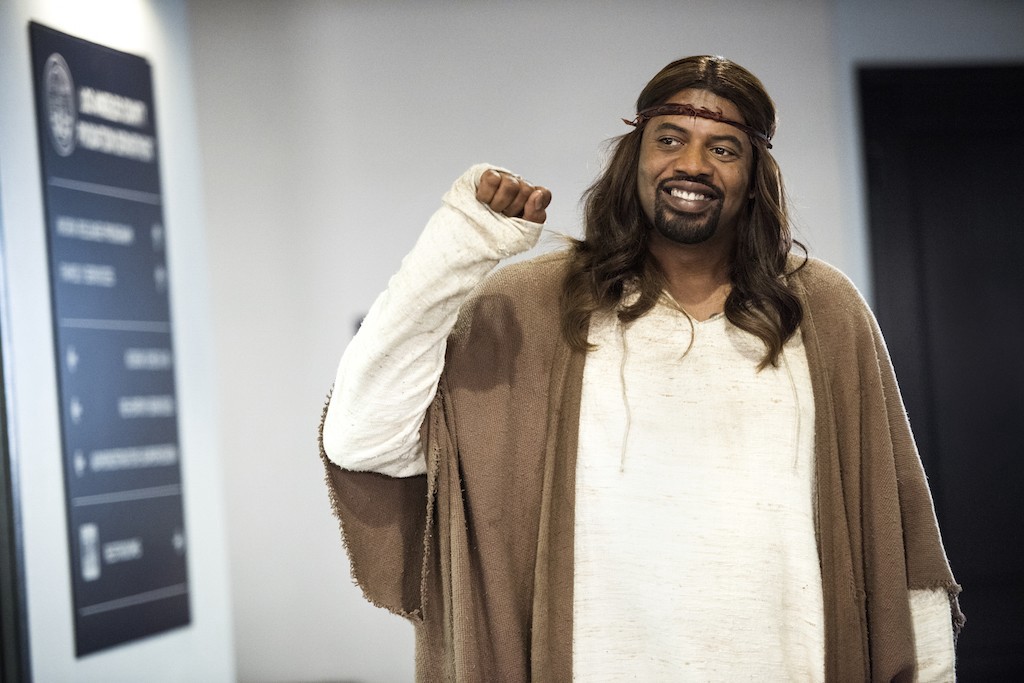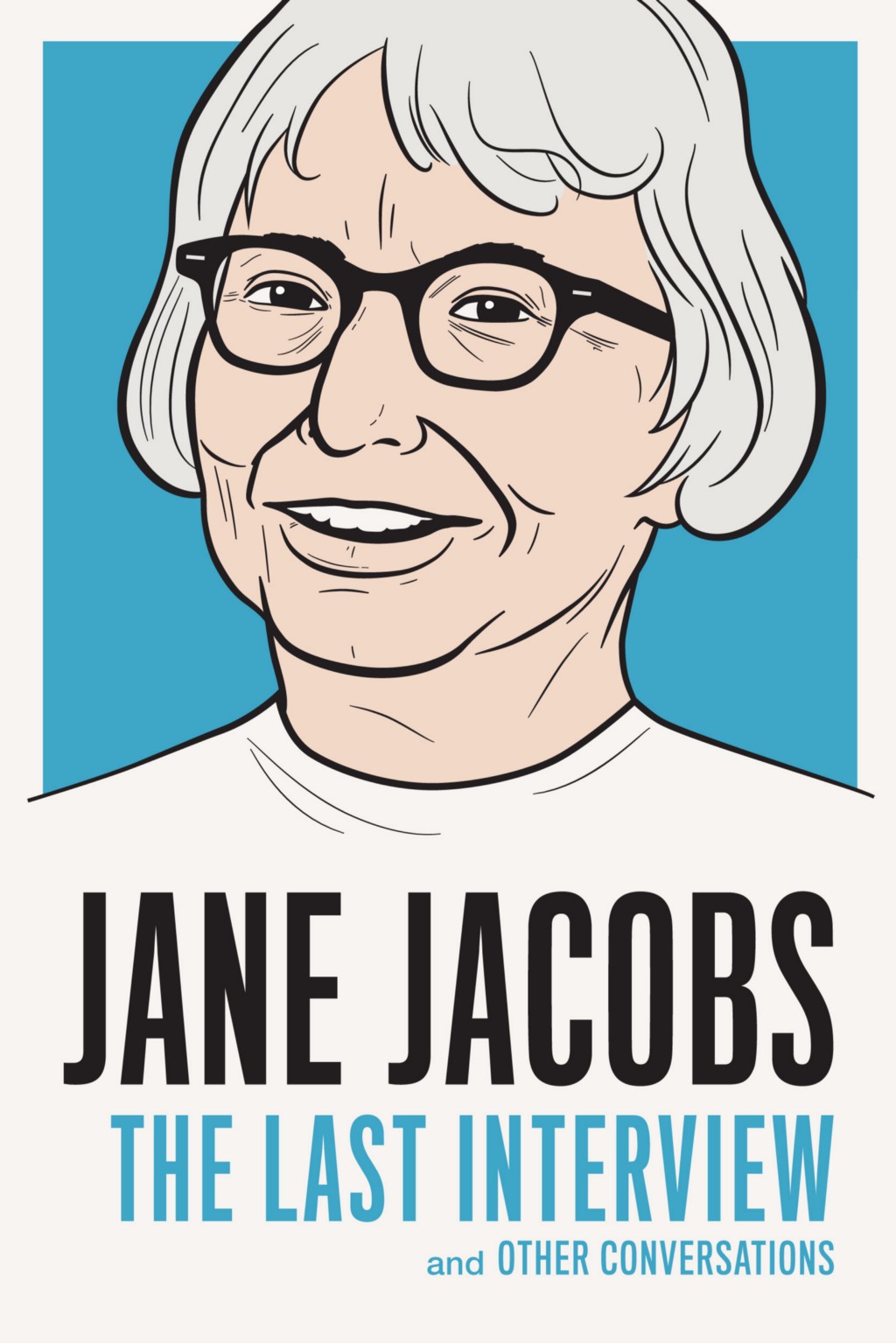Jesus of Narrative
by Mik Awake

In the summer of 2014, Aaron McGruder’s comedy series “Black Jesus” sparked a relatively small conflagration of self-righteousness, from little more than its title and premise. USA Today collected statements from both black and white religious leaders across the country who were disgusted by its depiction of Jesus Christ. A Christian media-watchdog site that tracks things like “lesbian kisses” told its followers that the show “makes a mockery of our Lord.” And before the season had aired, a Change.org petition to get the show canceled gathered almost 2,500 signatures. These people were angry, no doubt, at what they saw as the oxymoronic proximity of the two words, and the blasphemy they seemed to suggest. Imagine the fallout, these critics argued, if someone had made a TV show “mocking” the prophet Mohammed. Even critics who weren’t as race-baited or angry still felt that the show was a “spoof,” trying to undermine the idea of Jesus, and that, nevertheless, the power of Jesus’s teachings would “survive” the show.
Two seasons of “Black Jesus” later, and a third coming this year (as well as a feature film reportedly in development), the only thing anyone can seem to agree on about the series is that it is meant to be a satire, light fare, a stoner serial, or as AV Club’s Eric Thurm put it, “a pleasant, relatively mindless high.” That is fair and understandable, considering that the show shares a network with “Assy McGee” and “Mary Shelley’s Frankenhole.” But is it really a spoof? Is Black Jesus mindless, blaxploitative satire? I am here to tell ye that it is not. In fact, I am here to tell ye that “Black Jesus” is one of the most subversive and thought-provoking re-imaginings of the Jesus narrative you will ever see, and that it is the most under-appreciated show on television.
The show’s premise is blatantly silly — dumb, even. In the beginning, it was this aspect of the show — its stoner silliness and the reputation of its network — that kept me from watching. The fact that it lives on Adult Swim is a kind of sneaky art-audience trap. The series revolves around a tall thirty-something-year-old black man who sports a goatee, silky chestnut hair, and a flowing robe and sandals straight out of Ephesians. Gerald “Slink” Johnson plays Jesus with infectious, swaggering charm, and the character spends most of his waking hours getting into and out of trouble with his crew of acolytes, often whiling away entire days smoking weed, drinking malt liquor, and chilling in an apartment courtyard in Southwest Compton. The pilot episode is called “Smokin,’ Drinkin’, and Chillin’” after a goofy ditty Jesus likes to sing around his crew. And not unlike a majority of his friends, Black Jesus’s father, an entity referred to simply as “Pops,” is never around — one of the many tropes of black life that the show gives tongue-in-cheek existential heft.
How is this black man Jesus? Was he immaculately conceived? Is he a kind of melanin-infused clone of the one from Nazareth? Or more like an identical twin deal? Was there another Mary and Joseph situation? The show never explains. He just is Jesus. Of his divine lineage, the show seems to say: Don’t think too much about it. Even my choice not to capitalize the “his” in the previous sentence is part of the trickiness of talking about the character. Black Jesus performs seemingly petty miracles that get his crew out of pickles, each miracle accompanied by the same kitschy wind-chimes-in-a-breeze sound. He turns water into cognac. The bowl of his goblet is a red Dixie cup. He heals a trigger-happy Mexican gangbanger’s wound moments after having inflicted it with one of those antique slingshots David probably used to bean Goliath. He can tell if you need to incorporate more fiber into your diet. After a tense confrontation with a traffic cop who has just written his dilapidated van a ticket, Black Jesus watches the officer waddle away. “Hey Eugene,” he hollers, not without spite. “Go get your colon checked, pimp.” His disciple-friends think he’s a mooch. His nemesis calls him a con-man and a cult leader. He is fallible, compassionate, party-loving, unemployed, and black. He doesn’t seem to understand the value of money at all, but he knows the names and secrets of every stranger he meets. No one is ever really impressed by these abilities.
We laugh at Jesus’s cartoonish admixture of visual and verbal registers, the middling use of his divine powers, his mashup of Compton-slang and King James: “That dude frolicks hard,” he says of one of his goats. We laugh that he has goats. We laugh when he drops the biblical act altogether, dusty garments hanging like wings from his widespread arms: “You get money fucking with me!” This is funny — Our Lord and Savior using brash, contemporary idioms while in a desert robe. During a memorable guest appearance at the tail end of the first season, rapper Coolio (another anachronistic figure who rapped about paradise) voices a central paradox of the show when he says to Black Jesus, “You don’t even act like Jesus supposed to act.” Of course, what’s noteworthy here isn’t whether or not Coolio is right, but that the show is concerned with the question of how Jesus is supposed to act.
Every version of the Jesus story, whether written by atheists or believers, features some magnification of the demigod’s personality over another. A lot of thought goes into what gets magnified. Whether these depictions are tonally serious or tongue-in-cheek, whether they claim narrative lineage to the Bible or not, isn’t as important as the fact that Jesus lives, first, in story. He is Jesus of Narrative. And the Jesus of Narrative is very old, older than Jesus of Nazareth, as any Comparative Religion major will tell you; versions of the Christ character appear in ancient literatures long before the birth of the shepherd from Judea. Not even Christians own Jesus of Narrative. It’s easy to see how the pliability of Jesus of Narrative might seduce a brilliant provocateur like McGruder, whose Jesus remains surprisingly faithful to the core message of the New Testament. As Black Jesus reminds everyone ad nauseam, he has “come down here to spread love.” In the scheme of the show, this usually amounts to trying to feed people — via a community garden in the first season, then a taco truck in the second. Often, the response Black Jesus gets to his quixotic, idealistic calls for love is swift, brutal, and pragmatic: This is Compton. This is America. Money talks, love bullshit walks.
And, because Jesus has manifested in a black body, he has been saddled with the hardest job in the universe, a job so seemingly difficult that it’s actually funny he’s even trying. Now, don’t get me wrong. The show doesn’t have a clear, discernible message. Or if it does, words like “message” and “spoof” are little help in pinpointing what makes it by turns funny and powerful. As we laugh at the goats, the hair, the goblet, and his friend Boonie’s spat over child support, the show also turns our laughter back on itself: what’s so funny about a black man who talks like a thug preaching love and kindness? Is it funny that Black Jesus is preaching love and kindness in a broken-hearted ghetto of America, which lives in the shadows of Hollywood’s glittering Babylon? Isn’t this, the most unlikely place to find love and kindness, the only place for Jesus to be?
Indeed, if Jesus came to America in our current historical moment, he would most certainly be poor and invisible. As McGruder said in an interview with Vice, “It’s only because this story has been hijacked for so long, that the idea of Jesus as an actual poor person seems crazy. So really this is a show about people who are just like anyone else, except they don’t have shit. And in many ways, Jesus’s message is that you don’t need shit, you just need love and kindness.”
The uncomfortable laughter doesn’t stop at pushing class-race buttons. The show poses questions as much for white audiences as for black ones, believers and nonbelievers. Vanity, forgiveness, fundamentalism, free will, and consumerism: no moral or ethical dilemma is safe from the show’s kidding-not-kidding inquiry. When Black Jesus and his out-on-parole friend, Fish, find Lloyd, an alcoholic tramp, prone and half-naked in Fish’s living room after having ransacked the fridge, Black Jesus calms his irate friend: “Right now is not the time for anger, man. It’s the time for forgiveness, man. He sick.” Black Jesus scoops the bum into his arms and carries him down the staircase, in a pietà through the Compton looking glass. Bluesy guitar plays over a dissolve into a dreamlike vision: Bay and Appaloosa horses graze in the desolate alleyways of Compton, and just like that a running gag throughout Season One hearkening back to a manure heist gone awry transforms into a thing of surreal, ephemeral beauty.
Smash cut: Lloyd pissing in a barrel the next day.
In the opening shot of the final episode of the first season, Black Jesus sits alone in a diner. For the first time on the show, he is not wearing his flowing robe and sandals. Instead, he’s in a black hoodie, his long silky chestnut mane inexplicably gone. He bangs the table with his fist and other people in the restaurant cast suspicious, frightened glances at him, as he sits muttering to his “Pops.” Later that episode, while wandering through town, on the run from the police who will eventually lock him up in a mental ward, Black Jesus freezes in his tracks as an SUV swoops in out of nowhere. A white man in sunglasses hops out and yells, “I’m standing my ground!” before firing a huge revolver at Black Jesus, who ducks and flees over music reminiscent of “The Benny Hill Show” credits.
You have to go beyond America, beyond our present day, and beyond TV to find a depiction of a Jesus as original as “Black Jesus.” Take Ivan Karamozov’s “Grand Inquisitor” tale in The Brothers Karamazov, wherein Jesus is reincarnated during the Spanish Inquisition, only to be murdered by the Christian Inquisitors for his heretical message of renouncing worldly goods. The paradoxical message is that Jesus’s teachings in their purest form are radical and anti-authoritarian. To be Christ means to be loathed by the powerful and loved by the weak. So when you plant a version of Jesus in Spain during the Inquisition, or in a post-industrial American city, that message of love, kindness, and an equitable distribution of wealth can’t help but sound ridiculous, blasphemous even. And if we know anything about Jesus of Narrative, we know that there is only one way that his epic story can end. Spoiler alert: it’s hilarious.
Photo: Adult Swim
Soundscan Surprises, Week Ending 4/21
Back-catalog sales numbers of note from Nielsen SoundScan.

I think we all know what happened here.
1. PRINCE VERY BEST OF PRINCE 100,174 copies
2. PRINCE PURPLE RAIN 62,544 copies
3. PRINCE THE HITS/THE B-SIDES 24,142 copies
4. PRINCE 1999 13,123 copies
7. PRINCE ULTIMATE PRINCE 8,977 copies
9. PRINCE SIGN ‘O’ THE TIMES 6,272 copies
17. PRINCE DIRTY MIND 3,704 copies
18. PRINCE CONTROVERSY 3,596 copies
19. PRINCE AROUND THE WORLD IN A DAY 3,461 copies
29. PRINCE PARADE (UNDER THE CHERRY MOON) 2,818 copies
32. PRINCE ART OFFICIAL AGE 2,635 copies
72. PRINCE & THE NEW POWER GENERATION DIAMONDS & PEARLS 1,916 copies
111. PRINCE SYMBOL 1,586 copies
130. PRINCE HITS 1 1,477 copies
157. PRINCE FOR YOU 1,312 copies
(Previously.)
Photo: Flickr
Don't Worry About The "Surprisingly Common" Computer Viruses Infecting Our Critical Infrastructure
“Mikko Hypponen, chief research officer for Finland-based F-Secure, said that infections of critical infrastructure were surprisingly common, but that they were generally not dangerous unless the plant had been targeted specifically…. As an example, Hypponen said he had recently spoken to a European aircraft maker that said it cleans the cockpits of its planes every week of malware designed for Android phones. The malware spread to the planes only because factory employees were charging their phones with the USB port in the cockpit.”
— Everything is fine. Don’t give another thought to the airplanes and, uh, NUCLEAR POWER PLANTS that are infected with computer viruses.”
Howard, "Glass"
https://www.youtube.com/watch?v=BYRo1SwQk1w
Will it be cold or hot out today? Will the weather feel more like November or May? I don’t know and neither do you! That’s the beauty of the world we live in now: Everything’s such a lovely surprise. I guess bring a scarf just in case. Enjoy.
Credit Given
“[S]omething the Awl did was set out to be that anti-authoritarian brand for the Internet. They came to be at a time when there was a lot of content farms on the Web and chaos and not quality work. He created a brand that had a very strong identity and kept that identity in a very smart way. But you almost have to have an expertise in all the things you’re not doing to be that good at what you’re doing. He built a successful business and not just with the Awl but the entire Awl network.”
— Here’s a profile of Vox Media platform guru Choire Sicha, a remarkable man who single-handedly created a contrarian media organization through his own Herculean efforts and force of will before moving on to take a role as an ambassador to [SOMETHING ABOUT MOBILE AND APPS]. It’s a fascinating look at the new challenges facing an American hero.
New York City, April 25, 2016

★★★ The sky had held handsome scaly cirrus but then it was fully overcast, with grimy yellow tones. The forecasts on the front page and inside the paper were 12 degrees apart. Helicopter noise competed with viola practice. Walls and bushes cast weak shadows. The colder estimate was winning; the colder estimate was even too optimistic. The less day was left, the stronger the sun became. The shimmer among the building tops subsided, and the last of the light was almost clear.
Nangdo, "Whooo"
I am just playing this over and over this afternoon. As you are, I once was; as I am, so shall you be. Enjoy.
The Flight To Quality
“The mass media, whether it is the internet or TV or whatever, does not discriminate between varieties of content. So a funny cat video has the same ‘weight’ as footage of Syrian refugees stuck in hell. In the end, this just evens the whole spectrum out. Those people who are interested in something that isn’t simple distraction, something that requires a level of engagement, will still seek out the ‘good stuff.’”
— But will they pay for it? That is the question.
The Caribbean Left Hand
There is a “new” Professor Longhair album out, and here’s a nice piece on his legacy.
Godmother Of The American City
by James Howard Kunstler

James Howard Kunstler interviewed urbanist and author Jane Jacobs in her home in Toronto in March of 2001; the following is an excerpt from their conversation.
KUNSTLER: Tell me how you found yourself venturing into the life of a public intellectual.
JACOBS: I began writing articles right away. And this combined with my afternoons I had spent looking at different areas of the city, and I wrote a series of articles that Vogue bought about different areas of the city. The fur district — you see, they had something to do with the kinds of things that the readers of Vogue were presumably interested in — although I didn’t know who I was writing these for when I wrote them. But then I saw what I was doing, and I tried this.
KUNSTLER: It must have been exciting to sell magazine articles.
JACOBS: It was. I got $40 a piece for them.
KUNSTLER: That was a lot of money then.
JACOBS: A lot of money! Because at the job I had, I got twelve dollars a week. Of course I didn’t sell many of these. I wrote about the fur district, the flower district, the leather district — let me see — the diamond district, which was down on the Bowery then. So I was trying to be a writer all the time. And eventually, not right away, but later on, I got to write Sunday feature stories for the Herald Tribune. But I didn’t get paid as well for those. But then I wrote a few things for Q Magazine — oh, about manhole covers, how you could tell what was running underneath you by reading what was on the manhole covers.
KUNSTLER: You hadn’t gone to college, by the way.
JACOBS: I hadn’t wanted to go to school after I finished high school. I was so glad to get out.
KUNSTLER: Were you a troublemaker?
JACOBS: Yes.
KUNSTLER: I sympathize — I didn’t like school either.
JACOBS: I would break paper bags in the lunch room and make explosions, and I would be sent to the principal, and that kind of thing. I was not really a troublesome person. I was not really destructive in any way, but I was mischievous.
KUNSTLER: Were you a comedian?
JACOBS: Sort of, yeah.
KUNSTLER: One would have to suppose at the time that you wrote The Death and Life of Great American Cities that you were pretty ticked off at American culture. For instance you wrote, “It may be that we have become so feckless as a people that we no longer care how things do work, but only what kind of quick, easy outer impression they give.” And you wrote that around 1960, or the late fifties.
JACOBS: Yeah, I began in 1958 and finished it in 1960.
KUNSTLER: So what was your state of mind? Were you ticked off at American culture? Was it the culture of civic design? Was it Robert Moses? Was it some combination of those things? Was it the Bauhaus? What was it that was getting under your skin in those days?
JACOBS: What was getting immediately under my skin was this mad spree of deceptions and vandalism and waste that was called urban renewal. And the way it had been adopted like a fad and people were so mindless about it — and so dishonest about what was being done. That’s what ticked me off, because I was working for an architectural magazine, and I saw all this firsthand, and I saw how the most awful things were being excused.
KUNSTLER: You must have already been acquainted with things like Corbusier’s “Radiant City,” and some of the schemes from the twenties, and the Bauhaus. By this time, Gropius had become installed at Harvard and Mies Van der Rohe . . .
JACOBS: I didn’t have any feeling about these one way or another. It was just another way of building. I didn’t have any ideology, in short. When I wrote “we have become so feckless as a people,” I had no ideology.
KUNSTLER: But you were angry.
JACOBS: But I was angry at what was happening and at what I could see firsthand was happening. It all came to me firsthand. I didn’t have any abstractions about American culture. . .
But I’ll tell you something that had been worrying me: I liked to visit museums that showed old-time machines, and tools and so forth. . . I was very struck with the way these old machines were painted. They were painted in a way to show you how they worked. Evidently, the makers of them and the users of them cared about how these things were put together and how what moved what, so that other people would be interested in them. . .
In the meantime, along had come these locomotives that had skirts on them, and you couldn’t see how the wheels moved, and that disturbed me. And it was supposed to be for reasons of aerodynamics, but that didn’t make sense. And I began to notice how everything was being covered up, and I thought that was kind of sick.
KUNSTLER: So the streamlining of the thirties bugged you?
JACOBS: That’s right. So I remember very well what was in my mind [when I wrote] “that we have become so feckless as a people.” It was those skirts on the locomotives that I was thinking about, and how this had been extended — we didn’t care how our cities worked anymore. We didn’t care to show where the entrances were in buildings and things like that. That’s all I meant. It was not some enormous comment on abstract American society. And I thought, this is a real decadence of some sort.
From Jane Jacobs: The Last Interview and Other Conversations. Used with permission of Melville House. © 2000 by James Howard Kunstler. Expanded from Metropolis, March 2001.
